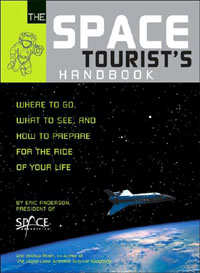Review: The Space Tourist’s Handbookby Jeff Foust
|
| One of the hallmarks of this book is a mix of practical and fanciful, even bizarre, advice. |
The Space Tourist’s Handbook is designed to be a guidebook of sorts of the various space tourism experiences available, from zero-g and high-altitude aircraft flights to suborbital and orbital spaceflight. The book provides an overview of these various experiences, as well as plenty of dos and don’ts for prospective tourists (as if someone contemplating spending $20 million on a flight to the ISS would rely on a book costing less than a millionth of that price for advice.) Piven’s influence on the book is very clear: there are many sections of the book (how to eject from an aircraft, how to extinguish a fire in space, how to survive a water landing) that look like they could come from a hypothetical The Worst-Case Scenario Survival Handbook: Space Edition.
One of the hallmarks of this book is a mix of practical and fanciful, even bizarre, advice. On the practical side, the book advises prospective space tourists to bring along a digital voice recorder on their flights: that is much easier to use in weightlessness than a pencil and paper. Elsewhere, the book describes how people on zero-g aircraft flights can “run” around the cabin in weightlessness—advice more likely to be of use to readers than how to extinguish a fire on the space station. On the other extreme, though, is this odd note about how to cooperate with other occupants on the ISS: “Though especially popular with Russian cosmonauts, playing chess on the Space Station is serious business and can lead to conflict. Politely decline any invitation to play.” Say what? If this intended to be humorous, that humor will likely be lost on most readers, buried among other tips on how to defuse any tensions among station occupants.
The book also has a number of errors and omissions. Some of the errors are minor typos: at one point the first space flight of SpaceShipOne is listed as June 22, 2004, not June 21. At another point, though, the book notes that “commercial development at L5 is currently promoted by the L5 Society.” Most people with some knowledge of space organizations, though, will know that the L5 Society has not existed since its merger with the National Space Institute in 1987—nearly 20 years ago!—to form the National Space Society. The discussion of suborbital vehicles in the book mentions some proposals like the Cosmopolis 21 and “MiG-31 derivatives”, but doesn’t mention other vehicles under active development, like those by Blue Origin, Canadian Arrow, and SpaceDev. Likewise, while the list of spaceports includes obvious choices like KSC and Baikonur, it includes either facilities not usually linked to space tourism (Kodiak in Alaska) or in the earliest proposal stages (Dubai) over more obvious choices like New Mexico, Oklahoma, or even Mojave Airport in California, where SpaceShipOne made its historic flights. The book’s design also leaves something to be desired: small light green text on white backgrounds (or vice versa) is almost illegible in some illustrations.
So, is The Space Tourist’s Handbook intended to be a serious take on space tourism? It is, after all, published by Quirk Books, a publisher whose mission statement states that the company is “inspired by the belief that a healthy appreciation for the absurd is the key to both happiness and success”. On the other hand, one of the co-authors, Anderson, runs arguably the most successful space tourism company around, and the book is being published along with a promotion that offers a suborbital spaceflight as the grand prize. The publisher’s web site even notes that Space Adventures’ instructors “are already integrating this handbook into their lesson plans.” So perhaps The Space Tourist’s Handbook is intended to be a serious, although imperfect, review of space tourism today. And, possibly, after years of dealing with the snicker factor, a sign that the industry can laugh at itself a bit.
